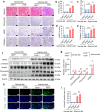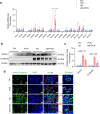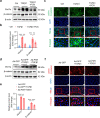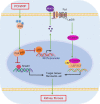Pregnane X receptor activation alleviates renal fibrosis in mice via interacting with p53 and inhibiting the Wnt7a/β-catenin signaling
- PMID: 37344564
- PMCID: PMC10545797
- DOI: 10.1038/s41401-023-01113-7
Pregnane X receptor activation alleviates renal fibrosis in mice via interacting with p53 and inhibiting the Wnt7a/β-catenin signaling
Abstract
Renal fibrosis is a common pathological feature of chronic kidney disease (CKD) with various etiologies, which seriously affects the structure and function of the kidney. Pregnane X receptor (PXR) is a member of the nuclear receptor superfamily and plays a critical role in regulating the genes related to xenobiotic and endobiotic metabolism in mammals. Previous studies show that PXR is expressed in the kidney and has protective effect against acute kidney injury (AKI). In this study, we investigated the role of PXR in CKD. Adenine diet-induced CKD (AD) model was established in wild-type and PXR humanized (hPXR) mice, respectively, which were treated with pregnenolone-16α-carbonitrile (PCN, 50 mg/kg, twice a week for 4 weeks) or rifampicin (RIF, 10 mg·kg-1·d-1, for 4 weeks). We showed that both PCN and RIF, which activated mouse and human PXR, respectively, improved renal function and attenuated renal fibrosis in the two types of AD mice. In addition, PCN treatment also alleviated renal fibrosis in unilateral ureter obstruction (UUO) mice. On the contrary, PXR gene deficiency exacerbated renal dysfunction and fibrosis in both adenine- and UUO-induced CKD mice. We found that PCN treatment suppressed the expression of the profibrotic Wnt7a and β-catenin in AD mice and in cultured mouse renal tubular epithelial cells treated with TGFβ1 in vitro. We demonstrated that PXR was colocalized and interacted with p53 in the nuclei of tubular epithelial cells. Overexpression of p53 increased the expression of Wnt7a, β-catenin and its downstream gene fibronectin. We further revealed that p53 bound to the promoter of Wnt7a gene to increase its transcription and β-catenin activation, leading to increased expression of the downstream profibrotic genes, which was inhibited by PXR. Taken together, PXR activation alleviates renal fibrosis in mice via interacting with p53 and inhibiting the Wnt7a/β-catenin signaling pathway.
Keywords: PXR; Wnt7a; chronic kidney disease; p53; renal fibrosis; β-catenin.
© 2023. The Author(s), under exclusive licence to Shanghai Institute of Materia Medica, Chinese Academy of Sciences and Chinese Pharmacological Society.
Conflict of interest statement
The authors declare no competing interests.
Figures











Similar articles
-
Gut Microbiota Affects Mouse Pregnane X Receptor Agonist Pregnenolone 16α-Carbonitrile-Induced Hepatomegaly by Regulating Pregnane X Receptor and Yes-Associated Protein Activation.Drug Metab Dispos. 2024 Jun 17;52(7):597-605. doi: 10.1124/dmd.123.001604. Drug Metab Dispos. 2024. PMID: 38697851
-
Pregnane X receptor (PXR) protects against cisplatin-induced acute kidney injury in mice.Biochim Biophys Acta Mol Basis Dis. 2021 Mar 1;1867(3):165996. doi: 10.1016/j.bbadis.2020.165996. Epub 2020 Oct 27. Biochim Biophys Acta Mol Basis Dis. 2021. PMID: 33127475
-
Loss of Klotho contributes to kidney injury by derepression of Wnt/β-catenin signaling.J Am Soc Nephrol. 2013 Apr;24(5):771-85. doi: 10.1681/ASN.2012080865. Epub 2013 Apr 4. J Am Soc Nephrol. 2013. PMID: 23559584 Free PMC article.
-
Pregnane X receptor: molecular basis for species differences in CYP3A induction by xenobiotics.Chem Biol Interact. 2001 May 16;134(3):283-9. doi: 10.1016/s0009-2797(01)00163-6. Chem Biol Interact. 2001. PMID: 11336976 Review.
-
Use of the nuclear receptor PXR to predict drug interactions.Toxicology. 2000 Nov 16;153(1-3):1-10. doi: 10.1016/s0300-483x(00)00300-0. Toxicology. 2000. PMID: 11090943 Review.
Cited by
-
p16INK4a Deletion Alleviated Obesity-Associated Kidney Fibrosis by Regulating Metabolic Reprogramming and the Inflammasome Pathway.J Cell Mol Med. 2025 Mar;29(5):e70444. doi: 10.1111/jcmm.70444. J Cell Mol Med. 2025. PMID: 40079088 Free PMC article.
-
Renal tubular epithelial cells response to injury in acute kidney injury.EBioMedicine. 2024 Sep;107:105294. doi: 10.1016/j.ebiom.2024.105294. Epub 2024 Aug 22. EBioMedicine. 2024. PMID: 39178744 Free PMC article. Review.
-
The crosstalk of Wnt/β-catenin signaling and p53 in acute kidney injury and chronic kidney disease.Kidney Res Clin Pract. 2024 Nov;43(6):724-738. doi: 10.23876/j.krcp.23.344. Epub 2024 Nov 18. Kidney Res Clin Pract. 2024. PMID: 39558651 Free PMC article.
-
Pulmonary fibrosis: from mechanisms to therapies.J Transl Med. 2025 May 8;23(1):515. doi: 10.1186/s12967-025-06514-2. J Transl Med. 2025. PMID: 40340941 Free PMC article. Review.
-
Anthraquinones from Rheum officinale Ameliorate Renal Fibrosis in Acute Kidney Injury and Chronic Kidney Disease.Drug Des Devel Ther. 2025 Jul 6;19:5739-5760. doi: 10.2147/DDDT.S521265. eCollection 2025. Drug Des Devel Ther. 2025. PMID: 40657042 Free PMC article. Review.
References
MeSH terms
Substances
LinkOut - more resources
Full Text Sources
Medical
Research Materials
Miscellaneous

